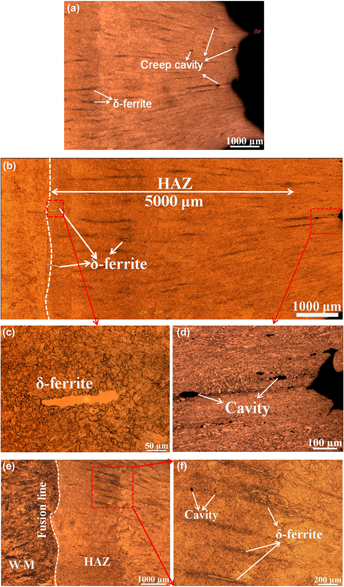Crossref Citations
This article has been cited by the following publications. This list is generated based on data provided by
Crossref.
Shao, Chendong
Lu, Fenggui
Li, Zhuguo
Cai, Yan
Wang, Peng
and
Ding, Yuming
2016.
Role of stress in the high cycle fatigue behavior of advanced 9Cr/CrMoV dissimilarly welded joint.
Journal of Materials Research,
Vol. 31,
Issue. 2,
p.
292.
Falat, Ladislav
Kepič, Ján
Čiripová, Lucia
Ševc, Peter
and
Dlouhý, Ivo
2016.
The effects of postweld heat treatment and isothermal aging on T92 steel heat-affected zone mechanical properties of T92/TP316H dissimilar weldments.
Journal of Materials Research,
Vol. 31,
Issue. 10,
p.
1532.
Lin, Runqi
Cui, Haichao
Lu, Fenggui
Huo, Xin
and
Wang, Peng
2016.
Study on the microstructure and toughness of dissimilarly welded joints of advanced 9Cr/CrMoV.
Journal of Materials Research,
Vol. 31,
Issue. 22,
p.
3597.
Wei, Yuanhang
Qiao, Shangfei
Lu, Fenggui
and
Liu, Wen
2016.
Failure transition mechanism in creep rupture of modified casting 9Cr-1.5Mo-1Co welded joint.
Materials & Design,
Vol. 97,
Issue. ,
p.
268.
Shao, Chendong
Lu, Fenggui
Wang, Xiongfei
Ding, Yuming
and
Li, Zhuguo
2017.
Microstructure characterization and HCF fracture mode transition for modified 9Cr-1Mo dissimilarly welded joint at different elevated temperatures.
Journal of Materials Science & Technology,
Vol. 33,
Issue. 12,
p.
1610.
Ding, Zong-ye
Zhang, Di
Hu, Qiao-dan
Zeng, Long
and
Li, Jian-guo
2017.
Constitutive analysis and optimization on hot working parameters of as-cast high Cr ultra-super-critical rotor steel with columnar grains.
Journal of Iron and Steel Research International,
Vol. 24,
Issue. 9,
p.
916.
Falat, Ladislav
Homolová, Viera
Čiripová, Lucia
Ševc, Peter
and
Svoboda, Milan
2017.
Ageing Effects on Microstructure, Mechanical Properties, and Fracture Behaviour of 9Cr-1.5Mo-1Co-VNbBN Martensitic Steel Welded Joint for High Temperature Application.
Advances in Materials Science and Engineering,
Vol. 2017,
Issue. ,
p.
1.
Wang, Jichao
Nie, Pulin
Qiao, Shangfei
Ojo, O. A.
Yao, Chengwu
Li, Zhuguo
and
Huang, Jian
2018.
Investigation on Microstructural Evolutions and Mechanical Properties of P92 Steel During Thermal Processing.
Journal of Materials Engineering and Performance,
Vol. 27,
Issue. 9,
p.
4392.
Ding, Kai
Ji, Hui-jun
Liu, Xia
Wang, Peng
Zhang, Quan-liang
Li, Xiao-hong
and
Gao, Yu-lai
2018.
Prevention of carbon migration in 9% Cr/CrMoV dissimilar welded joint by adding tungsten inert gas overlaying layer.
Journal of Iron and Steel Research International,
Vol. 25,
Issue. 8,
p.
847.
Qiao, Shangfei
Wei, Yuanhang
Xu, Huali
Cui, Haichao
and
Lu, Fenggui
2019.
The evolution behavior of second phases during long-term creep rupture process for modified 9Cr-1.5Mo-1Co steel welded joint.
Materials Characterization,
Vol. 151,
Issue. ,
p.
318.
Ding, Kai
Li, Xiaohong
Zhao, Bingge
Wang, Peng
Ding, Yuming
Lu, Fenggui
and
Gao, Yulai
2020.
Clarification of the false liquation crack existed in 9% Cr/CrMoV dissimilar welded joint by comparative etching process and in situ laser scanning confocal microscope.
Journal of Materials Research and Technology,
Vol. 9,
Issue. 3,
p.
6048.
Fang, Tao
Liu, Xia
Shao, Chendong
Cui, Haichao
and
Lu, Fenggui
2020.
Role of tempering cooling rate on impact toughness of 2CrMoV weld metal.
Journal of Materials Research,
Vol. 35,
Issue. 12,
p.
1612.
Ding, Kai
Zhao, Bingge
Huo, Xin
Fan, Manjie
Li, Xiaohong
Zhang, Yuanheng
Wei, Tao
Wu, Guanzhi
and
Gao, Yulai
2020.
Role of the V-Notch Location in the Impact Toughness of 9 Pct Cr-CrMoV Dissimilar Welded Joints.
Metallurgical and Materials Transactions A,
Vol. 51,
Issue. 4,
p.
1699.
Wu, Guanzhi
Ding, Kai
Wei, Tao
Liu, Xia
Fan, Manjie
He, Yi
Huo, Xin
and
Gao, Yulai
2022.
Coupled effect of temperature and stress on the microstructure and stress rupture behavior of 9% Cr-CrMoV dissimilar welded joints.
Engineering Failure Analysis,
Vol. 132,
Issue. ,
p.
105945.
El Ghor, Ahmad H.
Morovat, Mohammed Ali
Engelhardt, Michael D.
and
Hantouche, Elie G.
2022.
Creep Behavior of Transverse Welded Lap Joints at Elevated Temperatures.
Journal of Materials in Civil Engineering,
Vol. 34,
Issue. 6,
Jiang, Yunlu
Kan, Ying
and
Chen, Huaining
2022.
Heterogeneous Microstructure-Induced Creep Failure Responses in Various Sub-Zones of Modified 310S Welded Joints.
Metals,
Vol. 12,
Issue. 1,
p.
116.
Dak, Gaurav
Guguloth, Krishna
Bhattacharyya, Abir
Kumar, Pradeep
and
Pandey, Chandan
2023.
Failure Study of Creep and High-Temperature Tensile Tested Tungsten Inert Gas Welded P92 Steel and AISI 304L Steel Dissimilar Weld Joints.
Journal of Materials Engineering and Performance,





